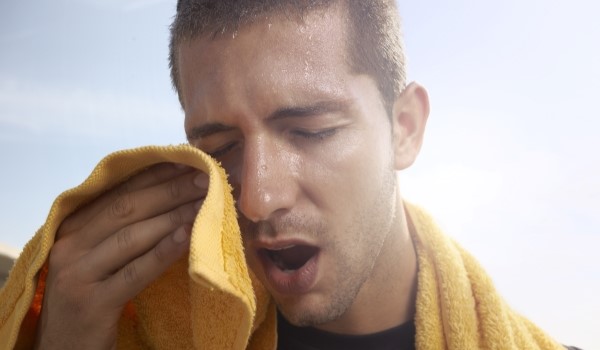What exactly is a
Hyperhidrosis?
Hyperhidrosis (also hyperhidrosis or excessive sweating) is a medical condition characterized by the uncontrolled and excessive production of sweat. Those affected suffer from significantly increased perspiration that exceeds normal levels and can occur regardless of external temperatures or physical activity.
About the symptoms
More information
Important facts about hyperhidrosis
Definition of hyperhidrosis
Hyperhidrosis is a medical condition and is not just due to a lack of hygiene or nervousness. Nevertheless, this condition can have a significant impact on quality of life, as sufferers may feel uncomfortable in social settings due to constant sweating. Fortunately, there are several treatment options to control sweating and improve quality of life. Hyperhidrosis can be primary or secondary. The primary form is idiopathic, meaning that there is no clear cause, and it often affects specific areas such as the palms of the hands, soles of the feet, armpits and/or face. Secondary hyperhidrosis, on the other hand, occurs as a reaction to certain medical conditions such as hormonal disorders, infections, neurological diseases or as a side effect of medication.
Symptoms and consequences of hyperhidrosis:
- Excessive sweat production, especially on the palms of the hands, soles of the feet, armpits and/or face. Often so severe that a frequent change of soaked clothing is necessary
- Sudden onset, without a recognizable trigger
- Unpleasant odor (due to bacterial decomposition of sweat)
- Skin irritation and fungal infections due to permanent moisture
- Callus formation on the hands or feet
- Increased risk of skin infections
- Reduced quality of life due to social embarrassment and self-confidence problems
What forms of hyperhidrosis are there?
Focal sweating
The primary form is the most common and occurs without an obvious cause. It often affects specific areas such as the palms of the hands, soles of the feet, armpits and/or face. The remaining areas of the body, on the other hand, sweat normally or to a lesser extent. It is estimated that around 1-3% of the population suffer from primary hyperhidrosis. This type of excessive sweating often begins in childhood or puberty and can last a lifetime.
Generalized sweating
The secondary form of hyperhidrosis, on the other hand, is less common than the primary form and occurs as a result of another underlying condition or as a side effect of medication. Generalized sweating, on the other hand, refers to an even distribution of excessive sweating over the entire body or several large areas. In this form of hyperhidrosis, sweating is not limited to specific areas of the body, but occurs everywhere or over larger areas.
What are the causes of generalized sweating?
The secondary form of hyperhidrosis occurs as a result of an underlying disease or as a side effect of certain medications. There are various causes of secondary hyperhidrosis, including
Hormonal causes
Hormonal causes
e.g. hormonal disorders such as hyperthyroidism and hypothyroidism or the menopause in women
Infectious causes
Infectious causes
e.g. tuberculosis, HIV or endocarditis infections
Neurological causes
Neurological causes
e.g. Parkinson's disease, stroke, multiple sclerosis, autonomic dysfunction
Drug-related causes
Drug-related causes
Side effects of certain medications such as antidepressants, antipyretics, antipsychotics, antihypertensives and hormone preparations
Other causes
Other causes
e.g. cancer, alcohol abuse or stress and anxiety
How is hyperhidrosis diagnosed?
An experienced doctor, usually a dermatologist or a general practitioner, can diagnose hyperhidrosis.
Medical history
Information about the type and frequency of sweating is collected here. Questions may include when the sweating occurs, which areas of the body are affected, whether there are specific triggers and how much the sweating affects the quality of life.
Investigations
During the physical examination, particular attention is paid to the affected areas of the body, such as the armpits, palms of the hands, soles of the feet and the face. If necessary, further examinations (including laboratory tests) will be carried out to determine whether the hyperhidrosis has a primary or secondary cause.
Special tests for focal hyperhidrosis
Certain sweat tests can help to objectively assess the severity of the disease. In gravimetry, the amount of weld is measured quantitatively by applying welding paper and then weighing it. In the iodine starch test, moist skin areas are identified by applying an iodine starch solution with a bluish color reaction.
Information about the type and frequency of sweating is collected here. Questions may include when the sweating occurs, which areas of the body are affected, whether there are specific triggers and how much the sweating affects the quality of life.
During the physical examination, particular attention is paid to the affected areas of the body, such as the armpits, palms of the hands, soles of the feet and the face. If necessary, further examinations (including laboratory tests) will be carried out to determine whether the hyperhidrosis has a primary or secondary cause.
Certain sweat tests can help to objectively assess the severity of the disease. In gravimetry, the amount of weld is measured quantitatively by applying welding paper and then weighing it. In the iodine starch test, moist skin areas are identified by applying an iodine starch solution with a bluish color reaction.
Sources
Please note that all content provided regarding individual medical conditions, treatments, procedures, etc. is general information and may vary depending on the physician:in and individual case and initial situation.
For more detailed information, please always consult your doctor.
Achenbach, R.K.: Hyperhidrosis, Springer Verlag, 2012
Schlereth, T.: "Hyperhidrosis - causes and therapy of excessive sweating", in: Dtsch Arztebl Int 2009; 106(3): 32-7
www.aerzteblatt.deGerman Dermatological Society (retrieved on 20.09.2021): Hyperhidrosis guideline
German Hyperhidrosis Center DHHZ (Retrieved 14.08.2021)
www.dhhz.de